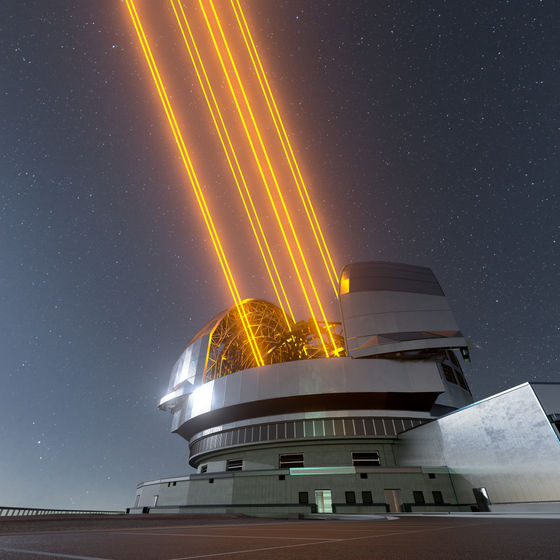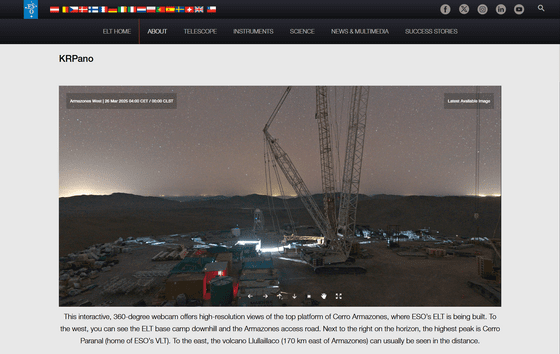Chile is building a 'super-large telescope' that could discover extraterrestrial life overnight

By
In life exploration to find out whether there is life on a distant planet, whether the planet has an atmosphere and its atmospheric composition are important clues, but it is very difficult to observe the thin layer of atmosphere that covers the surface of a small planet. The non-profit astronomy news site Universe Today has explained about the Extremely Large Telescope , which is being constructed in Chile and will be able to grasp the composition of the atmosphere of an exoplanet in just a few hours when it starts operating in 2029.
ELT | ESO
https://elt.eso.org/
[2503.08592] There's more to life in reflected light: Simulating the detectability of a range of molecules for high-contrast, high-resolution observations of non-transiting terrestrial exoplanets
https://arxiv.org/abs/2503.08592
The Extremely Large Telescope Could Sense the Hints of Life at Proxima Centauri in Just 10 Hours - Universe Today
https://www.universetoday.com/articles/the-extremely-large-telescope-could-sense-the-hints-of-life-at-proxima-centauri-in-just-10-hours
The Extremely Large Telescope (ELT), currently under construction on the 3,000-meter-high Cerro Amazonas in northern Chile, is a literally gigantic telescope with a primary mirror array with an effective diameter of 39 meters. When completed, it will be able to provide images of the universe 16 times clearer than those of the Hubble Space Telescope.

by
One of the ELT's most powerful capabilities is its ability to capture the faint atmospheric spectra emitted by exoplanet atmospheres. Currently, the atmospheres of other planetary systems are studied using the transit method , which captures the tiny amount of light that passes through the planet's atmosphere at the moment the planet passes in front of its host star and analyzes its absorption spectrum. This can help determine whether a planet has important ingredients for life, such as water, carbon dioxide, and oxygen, but the data is not always conclusive.
For example, the James Webb Space Telescope (JWST) has investigated planets orbiting the star TRAPPIST-1 , which is about 40.5 light years away from Earth, and so far it is believed that TRAPPIST-1b and TRAPPIST-1c do not have atmospheres, but the data is not strong enough to deny the existence of an atmosphere. However, it is expected that the ELT will be able to capture spectra from thin atmospheres that JWST could not observe, and clarify whether these planets really do not have atmospheres.
Furthermore, the transit method can only study planets when they pass in front of other stars, but with the precision of the ELT, it is expected that it will be possible to collect data on exoplanets that do not pass in front of their stars by using the reflected light from their stars.

by
To test this, University of Washington astronomers Victoria Meadows and Miles Curry simulated an observational scenario of a planet orbiting a red dwarf star, the most popular exoplanet.
The test cases were a pre-industrial Earth with plenty of water and photosynthetic plants, an early Archean Earth where life had begun to flourish, a pre-biotic Earth where no life existed yet but where it could potentially emerge, and a false positive planet similar to Earth but where the oceans have evaporated, like Mars and Venus. A Neptune-sized planet was also simulated for comparison.
The goal of choosing Earth and barren Earth-like planets as study subjects is to see whether the ELT can distinguish between various Earth-like planets and whether its observational data contains clues to distinguish between false positives and false negatives. If the ELT data did not contain any signs of false positives, there would be a risk that it would miss life when it exists, or mistake a barren planet for one teeming with life.

by
As a result of the verification, the research group found that accurate and clear data could be obtained for relatively nearby planetary systems. For example, in the case of a planet orbiting Proxima Centauri , the closest star to Earth, it was possible to detect the presence of life on an Earth-like planet after just 10 hours of observation. In addition, it was possible to capture the atmospheric spectrum of a Neptune-sized planet with a thick atmosphere after just one hour of observation.
Regarding the ELT, which is scheduled to make its first light into the telescope in 2029, Universe Today said, 'If there is life in a nearby planetary system, the ELT should be able to detect it. Perhaps the answer to the biggest question in human history may be found in just a few years.'
You can see how the ELT construction is progressing from the following.
Webcams | ELT | ESO
https://elt.eso.org/about/webcams/

Related Posts:
in Science, Posted by log1l_ks







